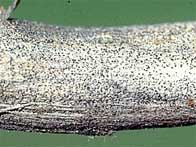June 13, 2005
 |
On a
soybean stem, the dark speckles are the sclerotia of the
charcoal rot pathogen.
(Image courtesy
William G. Willis, Kansas State University.) |
The first soybean line with
genetic resistance to charcoal rot has been released by
Agricultural Research Service
scientists in Mississippi.
Charcoal rot, caused by the
soilborne fungus Macrophomina phaseolina, is a major
yield-limiting disease of the Mid-South and other
soybean-producing regions throughout the world.
The new line, DT97-4290,
developed by scientists in the ARS
Crop Genetics and Production Research Unit at Stoneville, is
a potentially valuable source of resistance to charcoal rot for
soybean breeders and producers in areas experiencing yield
losses due to the disease.
Charcoal rot symptoms usually
appear when weather conditions are hot and dry, causing the
soybean plant to lose vigor. In more advanced stages, petioles
and leaves may turn yellow and wilt, while remaining attached to
the plant. No chemical controls currently exist for charcoal
rot, and resistance has been hard to identify.
Field studies were conducted at
Stoneville to find charcoal rot resistance among 24 selected
soybean genotypes. The researchers identified three breeding
lines with genetic resistance, according to
Bob Paris, the research geneticist who developed the line
with
Alemu Mengistu, a soybean pathologist.
The new line was selected for
its adaptation to the clay soils of the lower Mississippi River
valley, and for its field resistance to charcoal rot, soybean
mosaic virus and stem canker, and moderate resistance to frogeye
leafspot.
Genetic material of this
release will be deposited in the
National Plant Germplasm
System, where it will be available for soybean researchers
and breeders.
ARS is the
U.S. Department of Agriculture's
chief scientific research agency.
By
Jim Core,
USDA
Por
Jim Core
13 de junio 2005
La primera línea de soya con
una resistencia genética a la podredumbre carbonosa ha sido
lanzada por científicos del Servicio de Investigación Agrícola (ARS)
en Misisipí.
La podredumbre carbonosa, la
cual es causada por el hongo Macrophomina phaseolina, es una
enfermedad que limita significativamente los rendimientos de
soya en el Medio Sur y otras regiones a través del mundo donde
se cultiva la soya.
La línea nueva, llamada
DT97-4290, fue desarrollada por científicos de la
Unidad de Investigación de Genética y Producción de Cosechas
mantenida por ARS en Stoneville, Misisipí. La línea es una
fuente potencialmente valiosa de resistencia contra la
podredumbre carbonosa para los cultivadores y productores de
soya en áreas que sufren pérdidas de rendimientos debido a esta
enfermedad.
Los síntomas de la podredumbre
carbonosa típicamente aparecen cuando el tiempo es cálido y
seco, el cual causa que la planta de soya pierda su vigor. En
etapas más avanzadas de la enfermedad, las hojas y los pecíolos
pueden ponerse amarillos y marchitarse, mientras quedándose
conectados a la planta. Actualmente no hay controles químicos
para la podredumbre carbonosa, y la resistencia ha sido difícil
de identificar.
Estudios de campo fueron
realizados en Stoneville para encontrar la resistencia contra la
podredumbre carbonosa entre 24 genotipos seleccionados de soya.
Los investigadores identificaron tres líneas de crianza con una
resistencia genética, según
Bob Paris, el genetista que desarrolló la línea con el
patólogo
Alemu Mengistu.
La línea nueva fue seleccionada
por su adaptación a los suelos de arcilla del valle bajo del Rió
Misisipí, y por su resistencia en el campo a la podredumbre
carbonosa, el virus del mosaico de la soya y el cancro del
tallo, así como una resistencia moderada a la mancha en ojo de
sapo.
Materia genética de este
lanzamiento será depositada en el
Sistema Nacional del
Germen Plasma de Plantas, donde será disponible para los
investigadores y criadores de la soya.
ARS es la agencia principal
de investigaciones científicas del
Departamento de Agricultura de
EE.UU. |